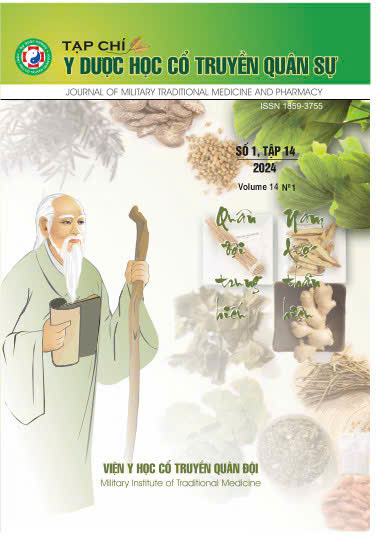TÁC DỤNG CHỐNG OXY HÓA CỦA CHẾ PHẨM TIÊU U HOÀN
Main Article Content
Abstract
Objective:This study evaluated the effects of Tieu u hoan (TUH) product on antioxidant. Experimental and methods: A model of liver damage with paracetamol using the positive control substance silymarin was created. 50 white mice were randomly divided into 5 groups. Evaluation criteria: TAS, SOD, GSH concentrations in plasma. Results: TUH has antioxidant effects, means that: the concentrations of TAS, SOD, GSH in two groups of TUH doses of 7.01g/kg and 14.02g/kg, respectively. Although, antioxidant enzymes were higher than that of the model batch, this difference was not statistically significant (p > 0.05). Conclussion: Tieu u hoan has antioxidant equivalent abilities similar to Silymarin
Article Details
Keywords
Tieu u hoan product, antioxidant.
References
2. Shahani S. (1999). “Evaluation of hepatoprotective efficacy of APCL-A polyherbal formulation in vivo in rats”. Indian Drugs (36). 628-631.
3. Cui Y., Yang X., Lu X., Chen J., Zhao Y (2014). “Protective effects of polyphenols-enriched extract from Huangshan Maofeng green tea against CCl4-induced liver injury in mice”. Chemico Biological Interactions 220 (5). 75-83.
4. Mohanraj S., Sangameswaran B., Santhosh K. C., Vinoth K. S., Atul N. C (2013). “Hepatoprotective effect of leaves of Morinda tinctoria Roxb. Against paracetamol induced liver damage in rats”. Drug Invention Today 5 (3). 223-228.
5. Shi Y., Sun J., He H., Guo H., Zhang S (2008). “Hepatoprotective effects of Ganoderma lucidum peptides against D-galactosamine induced liver injury in mice”. Journal of Ethnopharmacology 117 (3). 415-419.
6. Tamura A., Sasaki M., Yamashita H., Matsui Y. I., Saku T., Hikima T., Tabuchi M., Munakata H., Kojima Y. A. (2013). “Yerba-mate (Ilex paraguariensis) extract prevents ethanolinduced liver injury in rats”. Journal of Functional Foods 5 (4). 1714-1723.
7. Pari L., Murugan P (2004). “ Protective role of tetrahydrocurcumin against erythromycin estolateinduced hepatotoxicity”. Pharmacological Research 49 (5). 481-486.
8. Choi K. C., Chung W. T., Kwon J. K., Yu J. Y., Jang Y. S., Park S. M., Lee S. Y., Lee J. C (2010). “Inhibitory effects of quercetin on aflatoxin B1 induced hepatic damage in mice”. Food and Chemical Toxicology 48 (10) 2747-2753.
9. Sabina E. S., Samue J., Ramya S. R., Patel S., Mandal N., Preety P., Mishra P. P., Rasool M. K (2009). “Hepatoprotective and antioxidant potential of Spirulina fusiformis on acetaminophen induced hepatotoxicity in mice” . International Journal of Integrative Biology 6 (1). 1-5.
10. Trần Việt Đức (2020). “Tác dụng bảo vệ gan và chống oxy hóa của cao lỏng hồng chi Đà Lạt chủng DL1 trên mô hình gây tổn thương gan chuột nhắt trắng bằng paracetamol ở chuột nhắt trắng”. Tạp chí Nghiên cứu y học số 2. 126.
11. Nguyễn Hoàng Minh (2023). “Tác dụng bảo vệ gan của viên nang bạch hoa xà thiệt thảo-bán chi liên trên chuột bị tổn thương gan bởi paracetamol và ethanol”. Tạp chí Khoa học Trường Đại học Quốc tế Hồng Bàng, số 24-7/. 171-180.
12. Nguyễn Nhược Kim, Hoàng Minh Chung (2009). Dược học cổ truyền, NXB Y học. 210-2020


